قائمة مواقع التراث العالمي في أوروپا الغربية
خطأ لوا في وحدة:Location_map/multi على السطر 27: Unable to find the specified location map definition: "Module:Location map/data/Western Europe World Heritage Sites2" does not exist.
عين منظمة الأمم المتحدة للتربية والعلم والثقافة (اليونسكو) 131 موقع تراث عالمي في أوروپا الغربية. تقع هذه المواقع في 9 بلدان (وتسمى أيضاً "الأطراف السيادية")؛ تضم فرنسا وألمانيا معظمها بإجمالي 37 موقع، بين لا يوجد أي مواقع تراث عالمي في ليختنشتاين ومنواكو. وهناك عشرة مواقع تتشاركها أطراف دول داخل وخارج أوروپا الغربية.[1][2] أول موقع تم إدراجه من المنطقة على القائمة هو كاتدرائية آخن في ألمانيا عام 1978، سنة تصور القائمة.[3]
كل عام، قد تضيق لجنة التراث العالمي التابعة لليونسكو مواقع جديدة على القائدة، أو قد تغلي مواقع أخرى لم تعد موافية للمعيار. يعتمد الاختيار على عشرة معايير: ستة منها للتراث الثقافي (i–vi) وأربعة للتراث الطبيعي (vii–x).[4] بعض المواقع، قد تكون "مواقع مختلطة"، تمثل كلاً من التراث الثقافي والطبيعي.[5] في أوروپا الغربية، هناك 121 موقع ثقافي، 9 مواقع طبيعية، وموقعين مختلطين.[5]
قد تحدد لجنة التراث العالمي أيضاً أن موقع ما في خطر، مستشهدة "بالظروف التي تهدد السمات المميزة التي تم تسجيل الممتلكات الخاصة بها في قائمة التراث العالمي."[6] حالياً، لا يوجد أي موقع في أوروپا الغربية على قائمة المواقع المعرضة للخطر، على الرغم من أنه كان هناك موقعين ألمانيين ضم القائمة: كاتدرائية كولونيا في 2004 بسبب إنشاء عدد من المباني العالية حولها، لكنها خرجت من القائمة في 2006؛[7] ووادي درسدن إلبه كان ضم القائمة في 2006 أملاً في التوقف عن إنشاء جسر ڤالدشلوسخن ذو الأربع حارات عبر الوادي.[6][8][9] عند استمرار الانشاء كما هو مخطط له، سيصبح ثاني موقع تراث عالمي يخرج من القائمة في 2009، حيث كان أول موقع هو محمية المها العربي في عُمان قبل عامين.[10]
المفتاح
تستخدم القائمة التالية التعريف الثقافي لأوروپا الغربية (والتي تتضمن أيرلندا والمملكة المتحدة، على عكس تعريف التقسيم الاحصائي للأمم المتحدة) كما يحذف ستة مواقع خارج أوروپا تابعة لدول أوروپية: كوراساو (هولندا)، كاليدونيا الجديدة (فرنسا)، جزيرة ريونيون (فرنسا)، جزيرة گوف (المملكة المتحدة)، جزيرة هندرسون (المملكة المتحدة)، وبرمودا (المملكة المتحدة). هذه المواقع مدرجة ضمن قوائم التراث العالمي في أفريقيا، الأمريكتين وأوقيانوسيا. الجدول مرتب حسب الأعمدة بالضغط على ![]() في بداية العمود المطلوب؛ أبجدياً لأعمدة الموقع، المساحة، والسنة؛ حسب الدولة الطرف لعمود الموقع؛ حسب نوع المعيار لعمود المعيار.
في بداية العمود المطلوب؛ أبجدياً لأعمدة الموقع، المساحة، والسنة؛ حسب الدولة الطرف لعمود الموقع؛ حسب نوع المعيار لعمود المعيار.
- الموقع – الاسم الذي أُخذ منه التعيين الرسمي للجنة التراث العالمي.[5]
- الموقع – مرتب حسب البلد، حسب الاقليم أو المستوى الاقليمي والأحداثيات الجغرافية. في حالة المواقع متعددة الجنسيات أو الأقاليم، تُرتب الأسماء أبجدياً.
- المعيار – حسب لجنة التراث العالمي[4]
- المساحة – بالهكتار والفدان، تبعاً للمناطق العازلة إذا كان ذلك ممكناً. القيمة صفر تشير إلى أنه لم يتم نشر أي بيانات من قبل اليونسكو.
- السنة – التي تم إدراج الموقع فيها على قائمة التراث العالمي.
- الوصف – معلومات موجودة عن الموقع، وتشمل أسباب تأهله ليكون موقع معرض للخطر، إذا كان ممكناً.
المواقع
| Site | Image | Location | Criteria | Area ha (acre) |
Year | Description |
|---|---|---|---|---|---|---|
| كاتدرائية آخن |  |
Aachen, 50°46′28″N 6°5′4″E / 50.77444°N 6.08444°E |
ثقافي: (i), (ii), (iv), (vi) |
— | 1978 | An iconic feat of architecture that sparked copies around Germany for centuries to come, Aachen's cathedral became the first-built vaulted structure since antiquity. The town itself was closely tied to Charlemagne during the cathedral's inception, which explains why it became his burial place when he died in 814.[11] |
| Abbey and Altenmünster of Lorsch |  |
Lorsch, 49°39′13.284″N 8°34′6.888″E / 49.65369000°N 8.56858000°E |
ثقافي: (iii), (iv) |
— | 1991 | The abbey and gate or 'Torhall', are from the Carolingian era. The notable Carolingian sculptures and paintings are still in good condition.[12] |
| Abbey Church of Saint-Savin sur Gartempe | 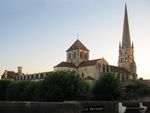 |
Vienne, 46°33′52.992″N 0°51′57.996″E / 46.56472000°N 0.86611000°E |
ثقافي: (i), (iii) |
0.16 (0.40) | 1983 | Often referred to as the "Romanesque Sistine Chapel", the church features well-preserved murals from the 11th and 12th cenutries.[13] |
| كاتدرائية أميان | 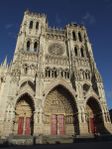 |
Amiens, 49°53′42″N 2°18′6″E / 49.89500°N 2.30167°E |
ثقافي: (i), (ii) |
1.37 (3.4) | 1981 | Amiens Cathedral is known as one of the classic Gothic churches of the 13th century. Following a devastating fire in 1218, it spent almost an entire 200 years under construction before taking on its current form in 1401, after which it has remained in great shape.[14] |
| Archaeological Ensemble of the Bend of the Boyne |  |
County Meath, 53°41′30.012″N 6°27′0″W / 53.69167000°N 6.45000°W |
ثقافي: (i), (iii), (iv) |
770 (1,900) | 1993 | The site is a unique testament to the longevity of several prehistoric and medieval settlements, featuring various cultural, artistic and scientific advancements that span four millennia.[15] |
| Arles, Roman and Romanesque Monuments |  |
Bouches-du-Rhône, 43°40′39.5″N 4°37′50.5″E / 43.677639°N 4.630694°E |
ثقافي: (ii), (iv) |
65 (160) | 1981 | The city, originally built in the 6th century BCE by Phocaean settlers from Greece, was remodelled by the Romans and slowly grew into an important metropolis, both politically and religiously. By 480, however, Arles was conquered by Barbarians and suffered a decline in its status until the 9th century, when Boso founded what would later become the Kingdom of Arles, where it regained its importance.[16] |
| Bauhaus and its sites in Weimar and Dessau |  |
Dessau and Weimar 50°58′29.172″N 11°19′46.164″E / 50.97477000°N 11.32949000°E |
ثقافي: (ii), (iv), (vi) |
— | 1996 | Formed in 1919, the original Bauhaus school in Weimar was known for its role in the progression of modern art through its architecture. Although it was shut down in 1925 for political reasons, Walter Gropius was able to establish a second and much more influential Bauhaus in Dessau months later, eventually attracting world-renowned artists to teach at the school before once again closing in 1933.[17] |
| بيمستر پولدر | 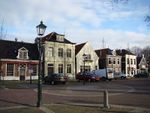 |
North Holland, 52°32′56″N 4°54′40″E / 52.54889°N 4.91111°E |
ثقافي: (i), (ii), (iv) |
— | 1999 | The early 17th century Beemster Polder, is a series of fields, roads, canals, dykes and settlements all built on land reclaimed from the sea.[18] |
| Belfries of Belgium and France | 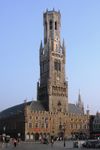 |
50°10′27.984″N 3°13′53.004″E / 50.17444000°N 3.23139000°E |
ثقافي: (ii), (iv) |
— | 1999 | The UNESCO entry covers 56 culturally significant belfries across France and Belgium, built over a period of several centuries.[19] |
| Benedictine Convent of St John at Müstair | 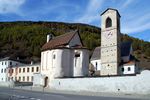 |
Müstair, 46°37′46.02″N 10°26′51.54″E / 46.6294500°N 10.4476500°E |
ثقافي: (iii) |
2,036 (5,030) | 1983 | The Convent of Müstair is a Christian monastery from the Carolingian period. It has Switzerland's greatest series of figurative murals, painted c. 800 AD, along with other Romanesque art and designs.[20] |
| Bergpark Wilhelmshöhe | 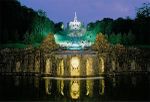 |
Kassel, 51°18′57″N 9°23′35″E / 51.31583°N 9.39306°E |
ثقافي: (iii), (iv) |
559 (1,380) | 2013 | Bergpark Wilhelmshöhe is the largest European hillside park, and second largest park on a mountain slope in the world. Its waterworks along with the towering Hercules statue constitute an expression of the ideals of absolutist Monarchy while the ensemble is a remarkable testimony to the aesthetics of the Baroque and Romantic periods.[21] |
| Berlin Modernism Housing Estates | 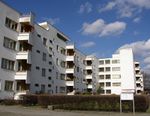 |
Berlin, 52°26′54″N 13°26′59.9″E / 52.44833°N 13.449972°E |
ثقافي: (ii), (iv) |
88 (220) | 2008 | The property consists of six housing estates from 1910 to 1933. It is an example of the building reform movement that contributed to improved housing and living conditions for people with low incomes. The estates also showcase a number of new designs, decoration and layouts. The lessons learned here were applied on other projects around the world. Some of the notable architects on these house were; Bruno Taut, Martin Wagner and Walter Gropius.[22] |
| Blaenavon Industrial Landscape | 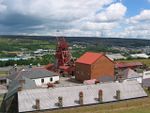 |
Torfaen, Wales, 51°46′35″N 3°5′17″W / 51.77639°N 3.08806°W |
ثقافي: (iii), (iv) |
3,290 (8,100) | 2000 | In the 19th century, Wales was the world's foremost producer of iron and coal. Blaenavon is an example of the landscape created by the industrial processes associated with the production of these materials. The site includes quarries, public buildings, workers' housing, and a railway.[23] |
| Blenheim Palace |  |
Woodstock, إنگلترة, 51°50′31″N 1°21′41″W / 51.84194°N 1.36139°W |
ثقافي: (ii), (iv) |
— | 1987 | Blenheim Palace, the residence of John Churchill, 1st Duke of Marlborough, was designed by architects John Vanbrugh and Nicholas Hawksmoor. The associated park was landscaped by Capability Brown. The palace celebrated victory over the French and is significant for establishing English Romantic Architecture as a separate entity from French Classical Architecture.[24] |
| Bordeaux, Port of the Moon | خطأ في إنشاء صورة مصغرة: الملف مفقود |
Gironde, 44°50′20″N 0°34′20″E / 44.83889°N 0.57222°E |
ثقافي: (ii), (iv) |
1,731 (4,280) | 2007 | A port city world-renowned for its wine industry, Bordeaux is also a coherent blend of classical and neo-classical architectural trends that symbolise the urban transformation from the 18th century onwards.[25] |
| Bourges Cathedral |  |
Bourges, 47°4′56″N 2°23′54″E / 47.08222°N 2.39833°E |
ثقافي: (i), (iv) |
0.85 (2.1) | 1992 | Originally built to confirm the ruling of the archdiocese and rebuilt due to fire, the cathedral is simplistic in its design, yet considered be a unique landmark of the city. Some of the medieval-era houses still surround the church.[26] |
| Canal du Midi |  |
Southern France, 43°36′41″N 1°24′59″E / 43.61139°N 1.41639°E |
ثقافي: (i), (ii), (iv), (vi) |
1,172 (2,900) | 1996 | Called "one of the greatest engineering achievements of the modern age", the 360 km (220 mi) Canal du Midi is the result of 17th-century projects that linked the Mediterranean Sea with the Atlantic Ocean, essentially setting the stage for the Industrial Revolution. Creator Pierre-Paul Riquet also placed heavy emphasis on the aesthetics of the waterway so that it would blend with its surroundings.[27] |
| Canterbury Cathedral, St Augustine's Abbey, and St Martin's Church |  |
Canterbury, إنگلترة, 51°16′48″N 1°4′59″E / 51.28000°N 1.08306°E |
ثقافي: (i), (ii), (vi) |
18 (44) | 1988 | St Martin's Church is the oldest church in England. The church and St Augustine's Abbey were founded during the early stages of the introduction of Christianity to the Anglo-Saxons. The cathedral exhibits Romanesque and Gothic architecture, and is the seat of the Church of England.[28][29][30] |
| Carolingian Westwork and Civitas Corvey |  |
Höxter, Germany, 51°46′41.8″N 9°24′36.9″E / 51.778278°N 9.410250°E |
ثقافي: (ii), (iii), (iv) |
12 (30) | 2014 | The abbey church was built between AD 822 and 885. Today the westwork is the only standing structure that dates back to the Carolingian era, while the ruins of the abbey are only partly excavated. It was an important center of early Frankish imperial administration and in the spread of Christianity in Germany.[31] |
| Castles and Town Walls of King Edward in Gwynedd |  |
Gwynedd, Wales, 53°8′23″N 4°16′37″W / 53.13972°N 4.27694°W |
ثقافي: (i), (iii), (iv) |
6 (15) | 1986 | During the reign of Edward I of England (1272–1307), a series of castles were constructed in Wales with the purpose of subduing the population and establishing English colonies in Wales. The World Heritage Site covers many castles including Beaumaris, Caernarfon, Conwy, and Harlech. The castles of Edward I are considered the pinnacle of military architecture by military historians.[32][33] |
| Castles of Augustusburg and Falkenlust at Brühl |  |
Brühl, North Rhine-Westphalia, 50°49′30.1″N 6°54′35.2″E / 50.825028°N 6.909778°E |
ثقافي: (ii), (iv) |
89 (220) | 1984 | Augustusburg Castle, the residence of the prince-archbishops of Cologne, and the Falkenlust hunting lodge are both examples of early German Rococo architecture.[34] |
| Cathedral of Notre-Dame, Former Abbey of Saint-Rémi and قصر تاو، Reims | 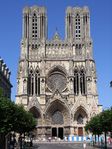 |
Reims, 49°15′12″N 4°1′58″E / 49.25333°N 4.03278°E |
ثقافي: (i), (ii), (vi) |
4.16 (10.3) | 1991 | Notre-Dame in Reims is one of the masterpieces of Gothic art. The former abbey still has its beautiful 9th-century nave, in which lie the remains of Archbishop St Rémi (440–533), who instituted the Holy Anointing of the kings of France. The former archiepiscopal palace known as the Tau Palace, which played an important role in religious ceremonies, was almost entirely rebuilt in the 17th century.[35] |
| The Causses and the Cévennes | 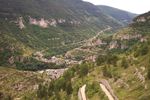 |
Southern France, 44°13′13″N 3°28′23″E / 44.22028°N 3.47306°E |
ثقافي: (iii), (v) |
302,319 (747,050) | 2011 | This site, in the southern part of central France, displays the relationship between local farming and the environment. The region is mountainous with numerous narrow valleys. The local farmers had to adapt to raise food in this difficult landscape. The valleys of the Causses were developed and controlled by large abbeys, starting in the 11th century. Mont Lozère is one of the last places where summer transhumance is still practiced in the traditional way.[36] |
| Chartres Cathedral | 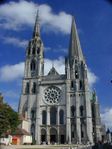 |
Chartres, 48°26′51″N 1°29′14″E / 48.44750°N 1.48722°E |
ثقافي: (i), (ii), (iv) |
1.06 (2.6) | 1979 | The cathedral was started in 1145 and rebuilt after a fire in 1194. It is a masterpiece of French Gothic art. The sculptures are from the 12th century and the stained-glass windows are from the 12th and 13th centuries.[37] |
| La Chaux-de-Fonds / Le Locle, Watchmaking Town Planning | 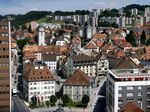 |
Canton of Neuchâtel, 47°6′14″N 6°49′58″E / 47.10389°N 6.83278°E |
ثقافي: (iv) |
284 (700) | 2009 | The site consists of two towns situated close to one another in a remote environment in the Swiss Jura mountains. Due to poor agricultural land, the watchmaking industry developed in the towns in the 19th century. After several devastating fires the towns were rebuilt to support this single industry. The town of La Chaux-de-Fonds was described by Karl Marx as a “huge factory-town” in Das Kapital where he analyzed the division of labour in the watchmaking industry of the Jura.[38] |
| Cistercian Abbey of Fontenay | 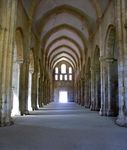 |
Marmagne, Côte-d'Or, 47°38′21.984″N 4°23′20.796″E / 47.63944000°N 4.38911000°E |
ثقافي: (iv) |
5.77 (14.3) | 1981 | The monastery was founded by St Bernard in 1119. The abbey was built to be self-sufficient and to isolate the residents from the outside world. In addition to the church and monks' quarters, it had a bakery and ironworks to help make it independent.[39] |
| City of Bath |  |
Somerset, إنگلترة, 51°22′53″N 2°21′31″W / 51.38139°N 2.35861°W |
ثقافي: (i), (ii), (iv) |
2,900 (7,200) | 1987 | Founded by the Romans as a spa, an important centre of the wool industry in the medieval period, and a spa town in the 18th century, Bath has a varied history. The city is preserved for its Roman remains and Palladian architecture.[40] |
| City of Graz – Historic Centre and Schloss Eggenberg | 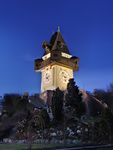 |
Styria, 47°4′27″N 15°23′30″E / 47.07417°N 15.39167°E |
ثقافي: (ii), (iv) |
— | 1999 | A branch of the Habsburg family lived in Graz for centuries. The Habsburgs and other local nobles beautified and expanded Graz over centuries, leading to a city with grand buildings in a number of styles.[41] |
| City of Luxembourg: its Old Quarters and Fortifications |  |
49°36′36″N 6°7′59.988″E / 49.61000°N 6.13333000°E |
ثقافي: (iv) |
30 (74) | 1994 | Luxembourg occupies a strategically important location in the region. Over the centuries it was traded back and forth by the great powers in Europe, each of which fortified and expanded the city. Though many of the walls were dismantled in 1867, portions still remain.[42] |
| Classical Weimar |  |
Thuringia, 50°58′39″N 11°19′42.996″E / 50.97750°N 11.32861000°E |
ثقافي: (iii), (vi) |
— | 1998 | Weimar became a cultural center in the late 18th and early 19th centuries. Among the many artists and writers, the city was home to Goethe and Schiller. During this same period elegant buildings and parks were built in Weimar.[43] |
| Collegiate Church, Castle, and Old Town of Quedlinburg | 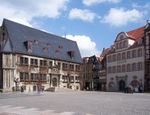 |
Harz, 51°46′59.988″N 11°9′0″E / 51.78333000°N 11.15000°E |
ثقافي: (iv) |
— | 1994 | The preservation of old Quedlinberg allows tourists to see 16th- and 17th-century timber-framed houses and walk down medieval-patterned streets, while the Romanesque castle and cathedral, housing the bodies of Henry I and his wife, tower over the town.[44] |
| كاتدرائية كولونيا | 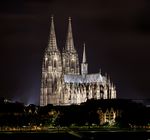 |
Cologne, 50°56′28″N 6°57′26″E / 50.94111°N 6.95722°E |
ثقافي: (i), (ii), (iv) |
— | 1996 | While work on the Cologne Cathedral began in 1248, it remained incomplete until the Prussians picked up the task centuries later, finishing the job in 1880. It was heavily bombed in the Second World War, but restorations allowed it to become the most visited landmark in Germany, boasting 6.5 million visitors per year as of 2011.[45][46] |
| Convent of St Gall |  |
St. Gallen, 47°25′23.988″N 9°22′40.008″E / 47.42333000°N 9.37778000°E |
ثقافي: (ii), (iv) |
— | 1983 | The Carolingian Convent of St Gall was one of the most important in Europe. It was in operation from the 8th century to its secularization in 1805. Its library is one of the richest and oldest in the world and contains a number of precious manuscripts such as the Plan of Saint Gall. Portions of the building were rebuilt in the Baroque style.[47] |
| Cornwall and West Devon Mining Landscape | 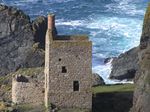 |
South West England, 50°8′10″N 5°23′1″W / 50.13611°N 5.38361°W |
ثقافي: (ii), (iii), (iv) |
19,719 (48,730) | 2006 | Tin and copper mining in Devon and Cornwall boomed in the 18th and 19th centuries, and at its peak the area produced two-thirds of the world's copper. The techniques and technology involved in deep mining developed in Devon and Cornwall were used around the world.[48] |
| Decorated Cave of Pont d’Arc, known as Grotte Chauvet-Pont d’Arc, Ardèche | 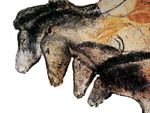 |
Vallon-Pont-d'Arc, 44°23′20″N 4°24′59″E / 44.38889°N 4.41639°E |
ثقافي: (i), (iii) |
9 (22) | 2014 | The cave is home to over 1000 paintings and drawing from about 30,000 to 32,000 years before present as well as flora and fauna remains. It contains the earliest and best preserved examples of prehistoric cave art. The art is especially notable for its use of color, motion, anatomical precision and three-dimensionality.[49] |
| خط الدفاع عن أمستردام |  |
Amsterdam, 52°22′28″N 4°53′35″E / 52.37444°N 4.89306°E |
ثقافي: (ii), (iv), (v) |
14,953 (36,950) | 1996 | Known in Dutch as the Stelling van Amsterdam, the 135-kilometre (84 mi) defence line surrounding the city was completed in 1920 to protect it from naval threats coming through the Markermeer. It was designed to temporarily flood the area comprising the line, enabling the 45 armed forts along it to effectively stage their countermeasures.[50] |
| Derwent Valley Mills |  |
Derbyshire, إنگلترة, 53°1′44″N 1°29′17″W / 53.02889°N 1.48806°W |
ثقافي: (ii), (iv) |
1,229 (3,040) | 2001 | The Derwent Valley Mills was the birthplace of the factory system; the innovations in the valley, including the development of workers' housing – such as at Cromford – and machines such as the water frame, were important in the Industrial Revolution. The Derwent Valley Mills influenced North America and Europe.[51][52] |
| Dorset and East Devon Coast | 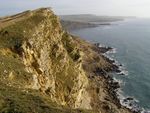 |
Dorset, إنگلترة, 50°42′20″N 2°59′23.6″W / 50.70556°N 2.989889°W |
Natural: (viii) |
2,550 (6,300) | 2001 | The cliffs that make up the Dorset and Devon coast are an important site for fossils and provide a continuous record of life on land and in the sea in the area since 185 million years ago.[53] |
| قلعة وكاتدرائية درم |  |
Durham, إنگلترة, 54°46′29″N 1°34′34″W / 54.77472°N 1.57611°W |
ثقافي: (ii), (iv), (vi) |
8.79 (21.7) | 1986 | Durham Cathedral is the "largest and finest" example of Norman architecture in England and vaulting of the cathedral was part of the advent of Gothic architecture. The cathedral houses relics of St Cuthbert and Bede. The Norman castle was the residence of the Durham prince-bishops.[54] |
| Episcopal City of ألبي | 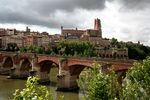 |
Tarn, 43°55′42″N 2°8′33″E / 43.92833°N 2.14250°E |
ثقافي: (iv), (v) |
19 (47) | 2010 | The once powerful Albi, originally founded as an agricultural town, gradually shifted its theme from fortifications to a much more classical Renaissance look that survives as a testament to the two eras in human history.[55] |
| Fagus Factory in Alfeld |  |
Alfeld, 51°59′1″N 9°48′40″E / 51.98361°N 9.81111°E |
ثقافي: (ii), (iv) |
1.88 (4.6) | 2011 | Built by Walter Gropius in 1910, the factory designed to manufacture shoe last was renowned for redefining decorative values of the time period, particularly in the wide use of glass to render the building much more homogeneous, which foreshadowed his later work with the Bauhaus.[56] |
| Fertö / Neusiedlersee Cultural Landscape | 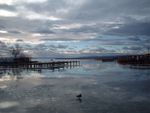 |
Burgenland and Győr-Moson-Sopron County, 47°43′9.4″N 16°43′21.8″E / 47.719278°N 16.722722°E |
ثقافي: (v) |
52 (130) | 2001 | The Fertö/Neusiedler Lake area has been occupied by different peoples for eight millennia. A number of 18th and 19th century villages and castles were built on top of the ancient settlements and landscape.[57] |
| Flemish Béguinages | 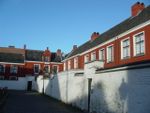 |
Flanders, 51°1′51.5″N 4°28′25.5″E / 51.030972°N 4.473750°E |
ثقافي: (ii), (iii), (iv) |
60 (150) | 1998 | The communities, called "béguinages", were built by the Béguines, religious women who "dedicated their lives to God without retiring from the world". Entire Flemish towns were created in the 13th century based on this principle of life.[58] |
| Fortifications of Vauban | 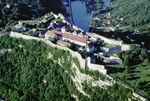 |
50°16′57″N 2°45′32″E / 50.28250°N 2.75889°E |
ثقافي: (i), (ii), (iv) |
1,153 (2,850) | 2008 | The UNESCO entry covers 12 groups of fortified buildings in France engineered by Sébastien Le Prestre, who worked under Louis XIV in the 17th century.[59] |
| The Four Lifts on the Canal du Centre and their Environs, La Louvière and Le Roeulx | 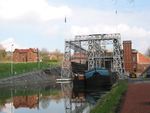 |
La Louvière, 50°28′51.996″N 4°8′13.992″E / 50.48111000°N 4.13722000°E |
ثقافي: (iii), (iv) |
67 (170) | 1998 | The hydraulic lifts along the Canal du Centre were made to overcome the 89.46-metre (293.5 ft) height difference between Mons and Charleroi. They are the last functioning lifts built at the turn of the 20th century.[60] |
| Frontiers of the Roman Empire |  |
Central Lowlands, Northern England, and Southern Germany 54°59′33.4″N 2°36′3.6″W / 54.992611°N 2.601000°W |
ثقافي: (ii), (iii), (iv) |
527 (1,300) | 1987 | Hadrian's Wall was built in 122 AD and the Antonine Wall was constructed in 142 AD to defend the Roman Empire from "barbarians".[61] The World Heritage Site was previously listed as Hadrian's Wall alone, but was later expanded to include all the frontiers of the Roman Empire at its zenith in the 2nd century, ranging from Antonine's Wall in the north to Trajan's Wall in eastern Europe.[5] |
| Garden Kingdom of Dessau-Wörlitz |  |
Saxony-Anhalt, 51°50′33″N 12°25′14.988″E / 51.84250°N 12.42083000°E |
ثقافي: (ii), (iv) |
14,500 (36,000) | 2000 | "The Garden Kingdom of Dessau-Wörlitz is an outstanding example of the application of the philosophical principles of the Age of the Enlightenment to the design of a landscape that integrates art, education and economy in a harmonious whole."[62] |
| Giant's Causeway and Causeway Coast | 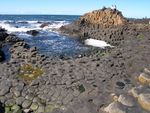 |
County Antrim, Northern Ireland, 55°15′0″N 6°29′7″W / 55.25000°N 6.48528°W |
Natural: (vii), (viii) |
70 (170) | 1986 | The causeway is made up of 40,000 basalt columns projecting out of the sea. It was created by volcanic activity in the Tertiary period.[63] |
| La Grand-Place, Brussels |  |
Brussels, 50°50′48.048″N 4°21′8.712″E / 50.84668000°N 4.35242000°E |
ثقافي: (ii), (iv) |
— | 1998 | Featuring Brussels' city hall, houses and other historic buildings, La Grand Place is a well-preserved testament to the social and cultural life of the late-17th century.[64] |
| Gulf of Porto: Calanche of Piana, Gulf of Girolata, Scandola Reserve | 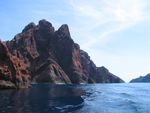 |
Corsica, 42°19′30.7″N 8°37′43.8″E / 42.325194°N 8.628833°E |
Natural: (vii), (viii), (x) |
11,800 (29,000) | 1983 | The Gulf of Porto is part of the Corsica Regional Park, hosting a variety of marine and avian life, as well as shrubland.[65] |
| Hallstatt-Dachstein / Salzkammergut Cultural Landscape |  |
Salzkammergut, 47°33′34″N 13°38′47″E / 47.55944°N 13.64639°E |
ثقافي: (iii), (iv) |
28,446 (70,290) | 1997 | The region built itself around salt mining, which began as early as 2,000 BCE and continued in the modern era. The region is also known for its mountain ranges and caves, the longest of the latter reaching a length of 81 km (50 mi).[66] |
| Hanseatic City of Lübeck | 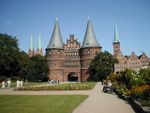 |
Schleswig-Holstein, 53°52′0.012″N 10°41′30.012″E / 53.86667000°N 10.69167000°E |
ثقافي: (iv) |
81 (200) | 1987 | Lübeck was the trading capital of the influential Hanseatic League, which monopolised trade in much of the Northern Europe. Although a fifth of the city was entirely destroyed in الحرب العالمية الثانية, much of the original 12th century architecture remains.[67] |
| Heart of Neolithic Orkney | 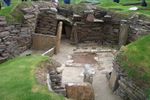 |
Mainland, Scotland, 58°59′45.8″N 3°11′19.2″W / 58.996056°N 3.188667°W |
ثقافي: (i), (ii), (iii), (iv) |
15 (37) | 1999 | A collection of Neolithic sites with purposes ranging from occupation to ceremony. It includes the settlement of Skara Brae, the chambered tomb of Maes Howe and the stone circles of Stenness and Brodgar.[68] |
| Historic Centre of Avignon: Papal Palace, Episcopal Ensemble and Avignon Bridge | 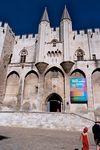 |
Vaucluse, 43°57′10″N 4°48′22″E / 43.95278°N 4.80611°E |
Culture: (i), (ii), (iv) |
8.2 (20) | 1995 | [69] |
| Historic Centre of Bruges | 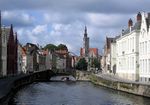 |
West Flanders, 51°12′32.076″N 3°13′30.972″E / 51.20891000°N 3.22527000°E |
ثقافي: (ii), (iv), (vi) |
410 (1,000) | 2000 | One of the economic and commercial capitals of Europe in the late-Medieval period, Bruges boasts its intact Gothic and neo-Gothic architecture, which respectively documents its style from the Middle Ages to the Renaissance.[70] |
| Historic Centre of Salzburg |  |
Salzburg, 47°48′2″N 13°2′36″E / 47.80056°N 13.04333°E |
ثقافي: (ii), (iv), (vi) |
236 (580) | 1996 | Best associated with Austrian composer Wolfgang Amadeus Mozart, Salzburg is known for its ecclesiastic city-state qualities only second to Vatican City. It is also where German and Italian cultures intersected, which is reflected by its blend of Gothic- and Baroque-style buildings.[71] |
| Historic Centre of Vienna | 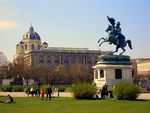 |
48°13′0″N 16°22′59″E / 48.21667°N 16.38306°E |
ثقافي: (ii), (iv), (vi) |
371 (920) | 2001 | "The historic centre of Vienna is rich in architectural ensembles, including Baroque castles and gardens, as well as the late-19th-century Ringstraße lined with grand buildings, monuments and parks."[72] |
| Historic Centres of Stralsund and Wismar | 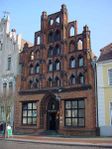 |
Mecklenburg-Vorpommern, 54°18′9″N 13°5′7″E / 54.30250°N 13.08528°E |
ثقافي: (ii), (iv) |
168 (420) | 2002 | The two towns were major Hanseatic League trading centres in the 14th and 15th centuries. They then served as defensive and administrative centres for Sweden two hundred years later, notably during the Thirty Years' War. The architectural styles from both of these periods remain and are well-preserved.[73] |
| Historic Site of Lyon |  |
Rhône, 45°46′1.992″N 4°49′59.988″E / 45.76722000°N 4.83333000°E |
ثقافي: (ii), (iv) |
427 (1,060) | 1998 | |
| Historic Fortified City of Carcassonne | 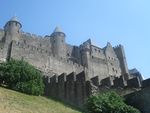 |
Aude, 43°12′38″N 2°21′32″E / 43.21056°N 2.35889°E |
ثقافي: (ii), (iv) |
11 (27) | 1997 | |
| Ir.D.F. Woudagemaal (D.F. Wouda Steam Pumping Station) | 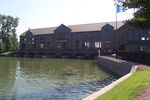 |
Lemmer, 52°50′44.988″N 5°40′44.004″E / 52.84583000°N 5.67889000°E |
Culture: (i), (ii), (iv) |
7.32 (18.1) | 1998 | |
| Ironbridge Gorge | 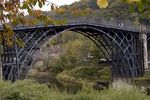 |
Shropshire, إنگلترة, 52°37′35″N 2°28′22″W / 52.62639°N 2.47278°W |
ثقافي: (i), (ii), (iv), (vi) |
— | 1986 | Ironbridge Gorge contains mines, factories, workers' housing, and the transport infrastructure that was created in the gorge during the Industrial Revolution. The development of coke production in the area helped start the Industrial Revolution. The Iron Bridge was the world's first bridge built from iron and was architecturally and technologically influential.[74] |
| Jurisdiction of Saint-Émilion |  |
Gironde, 44°53′41″N 0°9′19″E / 44.89472°N 0.15528°E |
ثقافي: (iii), (iv) |
7,847 (19,390) | 1999 | The act of cultivating grapes was introduced to the region by the Romans around 27 BCE and became a large and enduring part of its economy over the course of the following millennia, despite wars and the changes of rule. Occupying 67.5% of the total commune, the vineyards accompany historic monuments and buildings in documenting a monocultural community's history.[75] |
| Mill Network at Kinderdijk-Elshout | 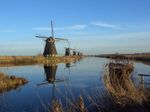 |
Alblasserdam and Nieuw-Lekkerland, 51°52′57″N 4°38′58″E / 51.88250°N 4.64944°E |
ثقافي: (i), (ii), (iv) |
— | 1997 | The first canals and pumps to drain the land for farming were built here in the Middle Ages. They have continued to be used and expanded into the present day. The network includes a number of dykes, reservoirs, pumping stations, administrative buildings and a series of windmills.[76] |
| Lavaux, Vineyard Terraces | 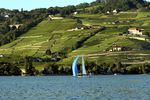 |
Vaud, 46°29′31″N 6°44′46″E / 46.49194°N 6.74611°E |
ثقافي: (iii), (iv), (v) |
1,408 (3,480) | 2007 | The Lavaux Vineyard Terraces stretch for about 30 km (19 mi) along the south-facing northern shores of Lake Geneva from Chillon Castle to the eastern outskirts of Lausanne in the Vaud region. The current terraces can be traced back to the 11th century, when Benedictine and Cistercian monasteries controlled the area.[77] |
| Le Havre, the City Rebuilt by Auguste Perret |  |
Seine-Maritime, 49°29′34.008″N 0°6′27″E / 49.49278000°N 0.10750°E |
ثقافي: (ii), (iv) |
133 (330) | 2005 | After their city was heavily bombed in الحرب العالمية الثانية, Le Havre officials commissioned Auguste Perret to lead a reconstruction project. Perret's final product was a city blending its original layout and spirit with modern construction methods, urban planning and an innovative exploitation of concrete.[78] |
| Liverpool – Maritime Mercantile City | 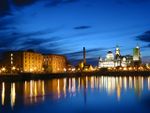 |
Merseyside, إنگلترة, 53°24′24″N 2°59′40″W / 53.40667°N 2.99444°W |
ثقافي: (ii), (iii), (iv) |
136 (340) | 2004 | In the 18th and 19th centuries, Liverpool was one of the largest ports in the world. Its global connections helped sustain the British Empire, and it was a major port involved in the slave trade until its abolition in 1807, and a departure point for emigrants to North America. The docks were the site of innovations in construction and dock management.[79] |
| The Loire Valley between Sully-sur-Loire and Chalonnes | 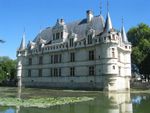 |
Loire Valley, 47°23′56.004″N 0°42′10.008″E / 47.39889000°N 0.70278000°E |
ثقافي: (i), (ii), (iv) |
85,394 (211,010) | 2000 | The Loire Valley contains historic towns and villages, castles and cultivated lands along the banks of the river Loire.[80] |
| Luther Memorials in Eisleben and Wittenberg |  |
Saxony-Anhalt, 51°51′52.992″N 12°39′10.008″E / 51.86472000°N 12.65278000°E |
ثقافي: (iv), (vi) |
— | 1996 | |
| Major Mining Sites of Wallonia |  |
Wallonia, 50°26′7″N 3°50′18″E / 50.43528°N 3.83833°E |
ثقافي: (ii), (iv) |
118 (290) | 2012 | |
| Major Town Houses of the Architect Victor Horta (Brussels) | 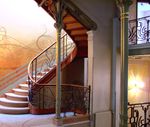 |
Brussels, 50°49′41.016″N 4°21′44.028″E / 50.82806000°N 4.36223000°E |
ثقافي: (i), (ii), (iv) |
— | 2000 | |
| Margravial Opera House Bayreuth | 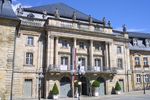 |
Bayreuth, Bavaria 49°56′40″N 11°34′43″E / 49.94444°N 11.57861°E |
ثقافي: (i), (iv) |
— | 2012 | |
| Maritime Greenwich | 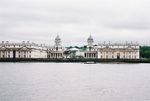 |
لندن, إنگلترة, 51°28′45″N 0°0′0″E / 51.47917°N 0.00000°E |
ثقافي: (i), (ii), (iv), (vi) |
110 (270) | 1997 | As well as the presence of the first example of Palladian architecture in England, and works by Christopher Wren and Inigo Jones, the area is significant for the Royal Observatory where the understanding of astronomy and navigation were developed.[81] |
| Maulbronn Monastery Complex |  |
Maulbronn, 49°0′2.988″N 8°48′47.016″E / 49.00083000°N 8.81306000°E |
ثقافي: (ii), (iv) |
— | 1993 | The Cistercian Maulbronn Monastery is considered the most complete and best-preserved medieval monastic complex north of the Alps. The main buildings were constructed between the 12th and 16th centuries, along with the monastery walls. The monastery's church, mainly in Transitional Gothic style, helped spread the Gothic style across northern and central Europe. The monastery also had a large, elaborate water-management system.[82] |
| Messel Pit Fossil Site |  |
Messel, 49°55′0.012″N 8°45′14.004″E / 49.91667000°N 8.75389000°E |
Natural: (viii) |
42 (100) | 1995 | Messel Pit is the richest site in the world for understanding the environment of the Eocene, between 57 million and 36 million years ago. In particular, it shows the early stages of mammalian evolution and includes exceptionally well-preserved mammal fossils. Some of the most notable discoveries include fully articulated skeletons and the contents of the stomachs of animals.[83] |
| Mines of Rammelsberg, Historic Town of Goslar and Upper Harz Water Management System | 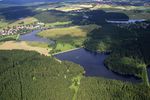 |
Goslar, Upper Harz, 51°49′12″N 10°20′24″E / 51.82000°N 10.34000°E |
ثقافي: (i), (ii), (iii), (iv) |
1,010 (2,500) | 1992 | The Upper Harz water management system was developed over a period of some 800 years to assist in mining and extracting ore. The mines and their ponds began under the Cistercian monks in the Middle Ages. However, most of the works were built from the end of the 16th century until the 19th century. It is made up of an extremely complex system of artificial ponds, small channels, tunnels and underground drains. The mines were a major site for mining innovation in the western world.[84] |
| Monastic Island of Reichenau | 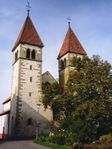 |
Baden-Württemberg, 47°41′55.4″N 9°3′40.7″E / 47.698722°N 9.061306°E |
ثقافي: (iii), (iv), (vi) |
— | 2000 | The site includes traces of the Benedictine monastery, founded in 724, which exercised remarkable spiritual, intellectual and artistic influence throughout the surrounding region. The churches of St Mary and Marcus, St Peter and St Paul, and St George, were mainly built between the 9th and 11th centuries. Their wall paintings and decorations show an impressive artistic activity.[85] |
| Mont-Saint-Michel and its Bay |  |
Manche, 48°38′8.016″N 1°30′38.016″W / 48.63556000°N 1.51056000°W |
ثقافي: (i), (iii), (vi) |
6,558 (16,210) | 1979 | Perched on a rocky islet in the midst of vast sandbanks exposed to powerful tides between Normandy and Brittany stands a Gothic-style Benedictine abbey, and the village that grew up under its walls. Both the abbey and the village had to overcome a number of challenges due to the small, rocky island. Built between the 11th and 16th centuries, the abbey is an incredible technical and artistic project.[86] |
| Monte San Giorgio | 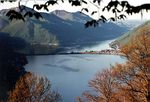 |
Ticino, 45°53′20″N 8°54′50″E / 45.88889°N 8.91389°E |
Natural: (viii) |
3,207 (7,920) | 2010 | The pyramid-shaped, wooded mountain of Monte San Giorgio beside Lake Lugano is regarded as the best fossil record of marine life from the Triassic Period (245–230 million years ago). The sequence records life in a tropical lagoon environment, sheltered and partially separated from the open sea by an offshore reef. Diverse marine life flourished within this lagoon, including reptiles, fish, bivalves, ammonites, echinoderms and crustaceans. Because the lagoon was near land, the remains also include land-based fossils of reptiles, insects and plants, resulting in an extremely rich source of fossils.[87] |
| Museumsinsel (Museum Island), Berlin | 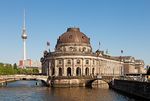 |
Berlin, 52°31′11″N 13°23′55″E / 52.51972°N 13.39861°E |
ثقافي: (ii), (iv) |
— | 1999 | The five museums on the Museumsinsel in Berlin, built between 1824 and 1930, are a unified but diverse collection of museum collections and buildings. Each museum was built to mesh with the collection and represents the aesthetic of the different times. The collections trace the development of civilizations throughout the ages.[88] |
| Muskauer Park / Park Mużakowski | 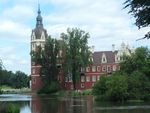 |
Upper Lusatia, 51°34′45.5″N 14°43′35.2″E / 51.579306°N 14.726444°E |
ثقافي: (i), (iv) |
348 (860) | 2004 | A landscaped park astride the Neisse River and the border between Poland and Germany, it was created by Prince Hermann von Puckler-Muskau from 1815 to 1844. Designed as a ‘painting with plants’, it used local plants to enhance the existing landscape. The park spreads into the town of Muskau with parks and other green spaces. The site also features a reconstructed castle, bridges and an arboretum.[89] |
| Van Nellefabriek |  |
Rotterdam, 51°55′24″N 4°25′6″E / 51.92333°N 4.41833°E |
ثقافي: (ii), (iv) |
6.94 (17.1) | 2014 | The factory was built in the 1920s as an "ideal factory", embracing the modernist and functionalist style of architecture. It was built of steel and glass with a large glass curtain wall to allow light fill the space. .[90] |
| Neolithic Flint Mines at Spiennes (Mons) |  |
Spiennes, 50°25′50.772″N 3°58′43.644″E / 50.43077000°N 3.97879000°E |
ثقافي: (i), (iii), (iv) |
172 (430) | 2000 | The Neolithic flint mines at Spiennes are the largest and earliest concentration of ancient mines in Europe. They are also remarkable for the diversity of innovations used in mining and due to a nearby Neolithic settlement.[91] |
| New Lanark | 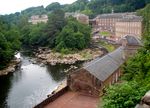 |
Lanark, Scotland, 55°39′48″N 3°46′59″W / 55.66333°N 3.78306°W |
ثقافي: (ii), (iv), (vi) |
146 (360) | 2001 | Prompted by Richard Arkwright's factory system developed in the Derwent Valley, the community of New Lanark was created to provide housing for workers at the mills. Philanthropist Robert Owen bought the site and turned it into a model community, providing public facilities, education, and supporting factory reform.[92] |
| Nord-Pas de Calais Mining Basin |  |
Nord-Pas de Calais, 50°27′45″N 3°32′46″E / 50.46250°N 3.54611°E |
ثقافي: (ii), (iv), (vi) |
3,943 (9,740) | 2012 | |
| Notre-Dame Cathedral in Tournai |  |
Tournai, 50°36′21.708″N 3°23′21.336″E / 50.60603000°N 3.38926000°E |
ثقافي: (ii), (iv) |
0.5 (1.2) | 2000 | The Cathedral of Notre-Dame in Tournai was built in the first half of the 12th century. The nave, transept and towers are all in the romanesque style. The choir was rebuilt in the following century in the gothic style. It is one of Wallonia's major heritage sites.[93] |
| Old City of Bern | 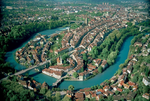 |
Bern, 46°56′53.016″N 7°27′1.008″E / 46.94806000°N 7.45028000°E |
ثقافي: (iii) |
84,684 (209,260) | 1983 | Founded in the 12th century on a hill site surrounded by the Aare River, Bern developed along the peninsula. Following a devastating fire, the entire town was rebuilt in a unified style. The early wooden buildings were replaced with sandstone, followed by arcades in the 15th century arcades and fountains in the 16th century. The medieval town was rebuilt in the 18th century, but retained its earlier character.[94] |
| Old and New Towns of Edinburgh |  |
Edinburgh, Scotland, 55°57′0″N 3°13′0″W / 55.95000°N 3.21667°W |
ثقافي: (ii), (iv) |
— | 1995 | The Old Town of Edinburgh was founded in the Middle Ages, and the New Town was developed in 1767–1890. It contrasts the layout of settlements in the medieval and modern periods. The layout and architecture of the new town, designed by luminaries such as William Chambers and William Playfair, influenced European urban design in the 18th and 19th centuries.[95] |
| Old Town of Regensburg with Stadtamhof | 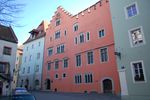 |
Regensburg, 49°1′14″N 12°5′57″E / 49.02056°N 12.09917°E |
ثقافي: (ii), (iii), (iv) |
183 (450) | 2006 | This medieval town contains many notable buildings that span almost two millennia and include ancient Roman, Romanesque and Gothic buildings. Regensburg’s 11th- to 13th-century architecture created a town of narrow, dark lanes flanked by tall buildings and surrounded by a city wall. It includes medieval patrician houses and towers, a large number of churches and monasteries as well as the 12th-century Old Bridge. Regensburg was a center of the Holy Roman Empire that turned to Protestantism.[96] |
| Palace and Gardens of Schönbrunn |  |
Vienna, 48°11′12″N 16°18′48″E / 48.18667°N 16.31333°E |
ثقافي: (i), (iv) |
186 (460) | 1996 | The residence of the Habsburg emperors from the 18th century to 1918. It was built in the rococo style as a single, unified project. It was designed by the architects Johann Bernhard Fischer von Erlach and Nicolaus Pacassi and was the site of the world's first zoo.[97] |
| Palace and Park of Fontainebleau | Fontainebleau, 48°24′7″N 2°41′53″E / 48.40194°N 2.69806°E |
ثقافي: (ii), (vi) |
144 (360) | 1981 | Used by the kings of France from the 12th century, the medieval royal hunting lodge of Fontainebleau was transformed, enlarged and embellished in the 16th century by François I, who wanted to make a 'New Rome' of it. Surrounded by an immense park, the Italianate palace combines Renaissance and French artistic elements.[98] | |
| Palace and Park of Versailles |  |
Versailles, 48°48′18″N 2°7′10″E / 48.80500°N 2.11944°E |
ثقافي: (i), (ii), (vi) |
1,070 (2,600) | 1979 | The Palace of Versailles was the principal residence of the French kings from the time of Louis XIV to Louis XVI. Embellished by several generations of architects, sculptors, decorators and landscape architects, it provided Europe with a model of the ideal royal residence for over a century.[99] |
| Palaces and Parks of Potsdam and Berlin |  |
Berlin, Potsdam, 52°23′59″N 13°1′59″E / 52.39972°N 13.03306°E |
ثقافي: (i), (ii), (iv) |
2,064 (5,100) | 1990 | This site contains 500 ha (1,200 acres) of parks and 150 buildings constructed between 1730 and 1916. It extends into the district of Berlin-Zehlendorf, with the palaces and parks lining the banks of the River Havel and Lake Glienicke. Voltaire stayed at the Sans-Souci Palace, built under Frederick II between 1745 and 1747.[100] |
| Paris, Banks of the Seine |  |
Paris, 48°51′30″N 2°17′39″E / 48.85833°N 2.29417°E |
ثقافي: (i), (ii), (iv) |
365 (900) | 1991 | The river Seine runs through the heart of Paris. The banks of the river are lined with many of Paris' most famous sites including the Louvre, the Eiffel Tower, the Place de la Concorde, the Cathedral of Notre-Dame, the Sainte Chapelle and the Grand and Petit Palais. The architecture and Haussmann's design with wide squares and boulevards influenced late 19th- and 20th-century town planning all over the world.[101] |
| Pilgrimage Church of Wies | 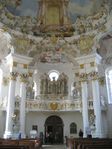 |
Steingaden, 47°40′52.6″N 10°54′0.5″E / 47.681278°N 10.900139°E |
ثقافي: (i), (iii) |
0.1 (0.25) | 1983 | The Church of Wies (1745–54) is the work of architect Dominikus Zimmermann and is a masterpiece of the Bavarian Rococo.[102] |
| Place Stanislas, Place de la Carrière and Place d'Alliance in Nancy |  |
Nancy, 48°41′37″N 6°10′59″E / 48.69361°N 6.18306°E |
ثقافي: (i), (iv) |
— | 1983 | Nancy is the oldest example of a capital city built as a unified whole and on modern principles. It was built between 1752 and 1756 by a brilliant team led by the architect Héré and is famous for the harmonious suite of axial spaces he developed, extending from the Place Stanislas to the Palais du Gouvernement.[103] |
| Plantin-Moretus House-Workshops-Museum Complex |  |
Antwerp, 51°13′5.988″N 4°23′52.008″E / 51.21833000°N 4.39778000°E |
ثقافي: (ii), (iii), (iv), (vi) |
— | 2005 | The Plantin-Moretus Museum is a printing plant and publishing house dating from the Renaissance and Baroque periods. It is associated with the history of the invention and spread of typography. Its name refers to the greatest printer-publisher of the second half of the 16th century: Christophe Plantin (c. 1520–89). The museum contains a collection made up of the work of the most prolific printing and publishing house in Europe in the late 16th century. The building of the company, which remained in activity until 1867, contains a large collection of old printing equipment, an extensive library, archives and works of art, among them a painting by Rubens.[104] |
| Pontcysyllte Aqueduct and Canal | 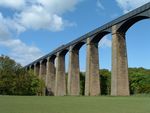 |
Wrexham, Wales, 52°58′13″N 3°5′16″W / 52.97028°N 3.08778°W |
ثقافي: (i), (ii), (iv) |
105 (260) | 2009 | The aqueduct was built to carry the Ellesmere Canal over the Dee Valley. Completed during the Industrial Revolution and designed by Thomas Telford, the aqueduct made innovative use of cast and wrought iron, influencing civil engineering across the world.[105] |
| Pont du Gard (Roman Aqueduct) |  |
Vers-Pont-du-Gard, 43°56′50″N 4°32′7″E / 43.94722°N 4.53528°E |
ثقافي: (i), (iii), (iv) |
0.33 (0.82) | 1985 | The Pont du Gard was built shortly before the Christian era in Rome to allow the aqueduct of Nîmes (which is almost 50 km (31 mi) long) to cross the Gard river. The Roman architects and hydraulic engineers who designed this bridge created a technical as well as an artistic masterpiece. The bridge stands almost 50 m (160 ft) high and is on three levels with the longest measuring 275 m (902 ft).[106] |
| Prehistoric pile dwellings around the Alps |  |
47°16′42″N 8°12′27″E / 47.27833°N 8.20750°E |
ثقافي: (iv), (v) |
3,961 (9,790) | 2011 | Contains 111 small individual sites with the remains of prehistoric pile-dwelling (or stilt house) settlements in and around the Alps built from around 5000 to 500 B.C. on the edges of lakes, rivers or wetlands. While only some of the sites have been excavated, they contain a wealth of information on life and trade in agrarian Neolithic and Bronze Age cultures in Alpine Europe. Fifty-six of the sites are located in Switzerland.[107] |
| Prehistoric Sites and Decorated Caves of the Vézère Valley | 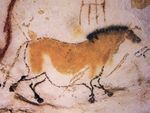 |
Lascaux, 45°3′27″N 1°10′12″E / 45.05750°N 1.17000°E |
ثقافي: (i), (iii) |
— | 1979 | The Vézère valley contains 147 prehistoric sites dating from the Palaeolithic and 25 decorated caves. The most interesting discoveries are the cave paintings, especially those of the Lascaux Cave, whose discovery in 1940 was of great importance for the history of prehistoric art. The hunting scenes show some 100 animal figures with remarkable color and detail.[108] |
| Primeval Beech Forests of the Carpathians and the Ancient Beech Forests of Germany |  |
49°5′10″N 22°32′10″E / 49.08611°N 22.53611°E |
Natural: (ix) |
33,670 (83,200) | 2007 | Primeval Beech Forests of the Carpathians, are used to study the spread of the beech tree (Fagus sylvatica) in the Northern Hemisphere across a variety of environments and the environment in the forest. The addition of the Ancient Beech Forests of Germany in 2011 included five forests totaling 4,391 hectares (10,850 acres) that are added to the 29,278 hectares (72,350 acres) of Slovakian and Ukrainian beech forests inscribed on the World Heritage List in 2007.[109] |
| Provins, Town of Medieval Fairs |  |
Provins, 48°33′35″N 3°17′56″E / 48.55972°N 3.29889°E |
ثقافي: (ii), (iv) |
108 (270) | 2001 | The fortified medieval town of Provins is situated in the former territory of the powerful Counts of Champagne. It was a center of international trading fairs and the wool industry. Many parts of the town were built especially for the fairs and markets.[110] |
| Pyrénées – Mont Perdu |  |
Hautes-Pyrénées and Province of Huesca, 42°41′7.512″N 0°0′1.8″E / 42.68542000°N 0.000500°E |
Mixed: (iii), (iv), (v), (vii), (viii) |
30,639 (75,710) | 1997 | This mountain landscape, which crosses the French and Spanish borders is centred around the peak of Mount Perdu. Mount Perdu is a calcareous massif that rises to 3,352 m (10,997 ft). The site includes two of Europe's largest and deepest canyons on the Spanish side and three major cirque valleys on the French side. In addition to the mountains, the site includes the cultural lifestyle of the seasonal herding migration in the mountains. This was one a common a way of life in the mountain valleys in Europe, but now mostly survives only in isolated ares such as this region in the Pyrénées.[111] |
| Rhaetian Railway in the Albula / Bernina Landscapes | 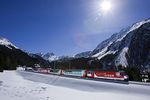 |
Graubünden and Tirano, 46°29′54″N 9°50′47″E / 46.49833°N 9.84639°E |
ثقافي: (ii) (iv) |
109,386 (270,300) | 2008 | The Rhaetian Railway in the Albula / Bernina Landscapes, brings together two historic railway lines that cross the Swiss Alps through those two passes. The railways provided a rapid and easy route into many formerly isolated alpine settlements. Building the railroads required overcoming a number of technical challenges with bridges and tunnels.[112] |
| Rietveld Schröder House | 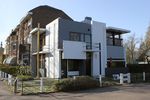 |
Utrecht, 52°5′7″N 5°8′50″E / 52.08528°N 5.14722°E |
ثقافي: (i), (ii) |
— | 2000 | The Rietveld Schröder House in Utrecht was built in 1924. A small family house with flexible interior rooms and a unique exterior. It is an example of the De Stijl group of artists and architects from the 1920s, and is an example of the Modern Movement in architecture.[113] |
| Roman Monuments, Cathedral of St. Peter and Church of Our Lady in Trier |  |
Trier, 49°45′0″N 6°37′59″E / 49.75000°N 6.63306°E |
ثقافي: (i)(iii), (iv), (vi) |
— | 1986 | The Roman colony at Trier was founded in the 1st century AD. It grew into a major town and became one of the capitals of the Tetrarchy at the end of the 3rd century. Many of the Roman era structures are still standing in Trier. The cathedral is the oldest church in Germany, being built on the ruins of Roman buildings by Maximin of Trier in 329-346.[114] |
| Roman Theatre and its Surroundings and the Triumphal Arch of Orange |  |
Orange, 44°8′8.6″N 4°48′30.3″E / 44.135722°N 4.808417°E |
ثقافي: (iii), (vi) |
9.45 (23.4) | 1981 | The ancient theatre of Orange, is one of the best preserved of all the great Roman theatres. The theatre features an intact 103 m (338 ft) facade. The Roman arch was built between A.D. 10 and 25 as a triumphal arch during the reign of Augustus.[115] |
| Routes of Santiago de Compostela in France |  |
45°11′2.6″N 0°43′22.6″E / 45.184056°N 0.722944°E |
ثقافي: (ii), (iv), (vi) |
— | 1998 | The site consists of a number of churches and hospitals that are places related to the pilgrimage to Santiago de Compostela in Western Spain, a part of the Way of Saint James.[116] |
| Royal Botanic Gardens, Kew |  |
لندن, إنگلترة, 51°28′55″N 0°17′38.5″E / 51.48194°N 0.294028°E |
ثقافي: (ii), (iii), (iv) |
132 (330) | 2003 | Created in 1759, the influential Kew Gardens were designed by Charles Bridgeman, William Kent, Capability Brown, and William Chambers. The gardens were used to study botany and ecology and furthered the understanding of the subjects.[117] |
| Royal Saltworks at Arc-et-Senans |  |
Arc-et-Senans, Salins-les-Bains, 46°56′15″N 5°52′35″E / 46.93750°N 5.87639°E |
ثقافي: (i), (ii), (iv) |
— | 1982 | This site consists of two open pan saltworks. The Royal Saltworks of Arc-et-Senans was built in 1775 during the reign of Louis XVI. It was built according to the principles of the Enlightenment, with a rational organization and layout. The other site, the Great Saltworks of Salins-les-Bains was active for at least 1200 years until stopping activity in 1962. The Saltworks of Salins has an underground gallery from the 13th century along with a 19th-century hydraulic pump and a boiler house. From 1780 to 1895, its salt water traveled through 21 km (13 mi) of wood pipes to the Royal Saltworks of Arc-et-Senans.[118] |
| Saltaire |  |
City of Bradford, إنگلترة, 53°50′21″N 1°47′18″W / 53.83917°N 1.78833°W |
ثقافي: (ii), (iv) |
20 (49) | 2001 | Saltaire was founded by mill-owner Titus Salt as a model village for his workers. The site, which includes the Salts Mill, featured public buildings for the inhabitants and was an example of 19th century paternalism.[119] |
| Schokland and Surroundings | 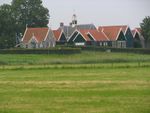 |
Noordoostpolder, 52°38′19″N 5°46′18″E / 52.63861°N 5.77167°E |
ثقافي: (iii), (v) |
1,306 (3,230) | 1995 | Schokland was a peninsula on the Zuider Zee that became an island by the 15th century. When the waters rose, it was abandoned in 1859. However after the draining of the Zuider Zee in the 1940s, it was once again repopulated.[120] |
| Semmering railway | 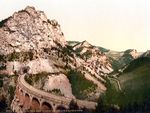 |
Gloggnitz, Simmering in Styria, 47°38′55.6″N 15°49′40.7″E / 47.648778°N 15.827972°E |
ثقافي: (ii), (iv) |
156 (390) | 1998 | The Semmering Railway, was built between 1848 and 1854 and covers 41 km (25 mi) of rugged mountains. This project was undertaken in the early days of railroad construction and required a number of innovations. The tunnels, viaducts and other works are still in use today.[121] |
| Seventeenth-century canal ring area of Amsterdam inside the Singelgracht |  |
Amsterdam, 52°21′54″N 4°53′16″E / 52.36500°N 4.88778°E |
ثقافي: (i), (ii), (iv) |
198 (490) | 2010 | By strategically draining the swamp land surrounding the port city via canal digging, Amsterdam quickly became a force in long-term city-planning, filling concentric voids with housing and infrastructure that would later accommodate the influx of free-thinking Europeans who help the city prosper.[122] |
| Skellig Michael | 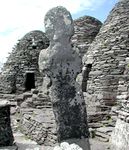 |
County Kerry, 51°46′18.984″N 10°32′18.996″W / 51.77194000°N 10.53861000°W |
ثقافي: (iii), (iv) |
22 (54) | 1996 | The monastery at Skellig Michael is from the 7th century. It is located on the rocky island of Skellig Michael, some 12 km (7.5 mi) off the coast of south-west Ireland. It shows the harsh and spartan lives of the first Irish Christians.[123] |
| Speyer Cathedral |  |
Speyer, 49°19′0″N 8°26′35″E / 49.31667°N 8.44306°E |
ثقافي: (ii) |
— | 1981 | The romanesque Speyer Cathedral, was founded by Conrad II in 1030 and remodelled at the end of the 11th century. It was one of the grandest romanesque cathedrals in the Holy Roman Empire and the burial place of German emperors for almost 300 years.[124] |
| St Kilda | 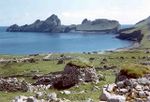 |
St Kilda, Scotland, 57°49′2″N 8°34′36″W / 57.81722°N 8.57667°W |
Mixed: (iii), (v), (vii), (ix), (x) |
24,201 (59,800) | 1986 | Although inhabited for over 2,000 years, the isolated archipelago of St Kilda has had no permanent residents since 1930. The islands' human heritage includes various unique architectural features from the historic and prehistoric periods. St Kilda is also a breeding ground for many important seabird species including the world's largest colony of gannets and up to 136,000 pairs of puffins.[125][126] |
| St. Mary's Cathedral and St Michael's Church at Hildesheim | 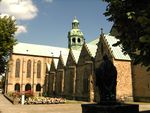 |
Hildesheim, 52°9′10.008″N 9°56′38.004″E / 52.15278000°N 9.94389000°E |
ثقافي: (i), (ii), (iii) |
0.58 (1.4) | 1985 | The site consists of two churches in Hildesheim. The Ottonian romanesque St Michael's Church was built between 1010 and 1020. Inside it is decorated with a notable wooden ceiling, painted stucco-work, and the Bernward Column. The treasures of the Romanesque Hildesheim Cathedral contain the Bernward Doors, the Hezilo chandelier and the Azelin chandelier.[127] |
| Stoclet House |  |
Brussels, 50°50′6″N 4°24′58″E / 50.83500°N 4.41611°E |
ثقافي: (i), (ii) |
0.86 (2.1) | 2009 | This house was built by the architect Josef Hoffmann for the banker Adolphe Stoclet starting in 1905. The house and garden were completed in 1911 and the angular undecorated design marked a turning point in Art Nouveau movement. The house is an excellent example of the Vienna Secession movement in art and architecture. The house is decorated with works by Koloman Moser and Gustav Klimt.[128] |
| Stonehenge, Avebury and Associated Sites | 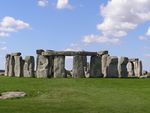 |
Wiltshire, إنگلترة, 51°10′44″N 1°49′31″W / 51.17889°N 1.82528°W |
ثقافي: (i), (ii), (iii) |
4,985 (12,320) | 1986 | The Neolithic sites of Avebury and Stonehenge are two of the largest and most famous megalithic monuments in the world. They relate to man's interaction with his environment. The purpose of the henges has been a source of speculation, with suggestions ranging from ceremonial to interpreting the cosmos. "Associated sites" includes Silbury Hill, Beckhampton Avenue, and West Kennet Avenue.[129] |
| Strasbourg – Grande île | 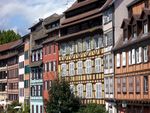 |
Strasbourg, 48°34′53″N 7°43′48″E / 48.58139°N 7.73000°E |
ثقافي: (i), (ii), (iv) |
94 (230) | 1988 | The Grande Ile (Big Island) is the historic center of the Alsatian capital and includes a number of historic buildings. Some of the most notable include the cathedral, the four ancient churches and the Palais Rohan (the former residence of the prince-bishops).[130] |
| Studley Royal Park including the Ruins of Fountains Abbey |  |
North Yorkshire, إنگلترة, 54°6′58″N 1°34′23″W / 54.11611°N 1.57306°W |
ثقافي: (i), (iv) |
— | 1986 | Before the Dissolution of the Monasteries in the mid-16th century, Fountains Abbey was one of the largest and richest Cistercian abbeys in Britain and is one of only a few that survives from the 12th century. The later garden, which incorporates the abbey, survives to a large extent in its original design and influenced garden design in Europe.[131] |
| Swiss Alps Jungfrau-Aletsch |  |
Cantons of Bern and Valais, 46°30′0″N 8°1′59″E / 46.50000°N 8.03306°E |
Natural: (vii), (viii), (ix) |
82,400 (204,000) | 2007 | The site includes several of the highest mountains in the Central Alps along with the largest glacier in Eurasia. The landscape provides information on the succession of plants after the retreat of a glacier and allows study of the retreat of glaciers resulting from climate change. The impressive landscape has also played an important role in European art, literature, mountaineering and tourism.[132] |
| Swiss Tectonic Arena Sardona | 
|
Glarus, St. Gallen and Graubünden, 46°55′0″N 9°15′0″E / 46.91667°N 9.25000°E |
Natural: (viii) |
32,850 (81,200) | 2008 | The Swiss Tectonic Arena Sardona in the north-eastern part of the country covers a mountainous area which features seven peaks that rise above 3,000 m (9,800 ft). The area displays an exceptional example of mountain building through continental collision and displays a clear example of tectonic thrust, i.e. the process whereby older, deeper rocks are carried onto younger, shallower rocks. The site has been a key site for the geological sciences since the 18th century.[133] |
| Three Castles of Bellinzona | 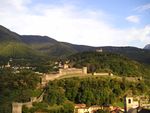 |
Bellinzona, 46°11′35.304″N 9°1′20.712″E / 46.19314000°N 9.02242000°E |
ثقافي: (iv) |
— | 2000 | The Bellinzona site consists of a group of fortifications grouped around the castle of Castelgrande, which stands on a rocky peak looking out over the entire Ticino valley. Running from the castle, a series of fortified walls protect the ancient town and block the passage through the valley. A second castle (Montebello) forms an integral part of the fortifications, while a third but separate castle (Sasso Corbaro) was built on an isolated rocky promontory south-east of the other fortifications.[134] |
| Tower of London |  |
لندن, إنگلترة, 51°30′29″N 0°4′34″W / 51.50806°N 0.07611°W |
ثقافي: (ii), (iv) |
— | 1988 | Begun by William the Conqueror in 1066 during the Norman conquest of England, the Tower of London is a symbol of power and an example of Norman military architecture that spread across England. Additions by Henry III and Edward I in the 13th century made the castle one of the most influential buildings of its kind in England.[135] |
| Town Hall and Roland on the Marketplace of Bremen | 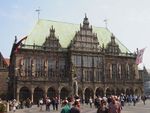 |
Bremen, 53°4′33.5″N 8°48′26.9″E / 53.075972°N 8.807472°E |
ثقافي: (iii), (iv), (vi) |
0.29 (0.72) | 2004 | The site consists of the Town Hall and the statue of Roland that stands near the town hall. The town hall was built in the 15th century when Bremen joined the Hanseatic League. It was renovated in the 17th century and a new Town Hall was built nearby in the early 20th. Under the Holy Roman Empire, Bremen had extensive autonomy which allowed the town to grow and made the town hall a center of power. Both the old and new Town Halls survived bombings during World War II. The statue of Roland was built in 1404. It stands 5.5 m (18 ft) high.[136] |
| Town of Bamberg | 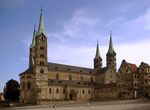 |
Bamberg, 49°53′30″N 10°53′20″E / 49.89167°N 10.88889°E |
ثقافي: (ii)(iv) |
142 (350) | 1993 | In 1007, Bamberg became the center of a dioesce that was intended to help spread Christianity to the Slavs. During the 12th century the Bishops of Bamberg began a program of monumental public construction. The architecture that developed influenced construction in northern Germany and Hungary. In the 18th century it became a center of the Enlightenment when writers such as Hegel and Hoffmann settled in the town.[137] |
| Upper Middle Rhine Valley | 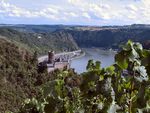 |
Rhineland-Palatinate, Hesse, 50°10′25″N 7°41′39″E / 50.17361°N 7.69417°E |
ثقافي: (ii), (iv), (v) |
27,250 (67,300) | 2002 | A 65 km (40 mi) stretch of the Middle Rhine Valley in Germany. The region is home to many castles, historic towns and vineyards and has been an inspirition for many writers, artists and composers.[138] |
| Vézelay, Church and Hill | 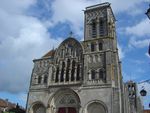 |
Vézelay, 47°27′59″N 3°44′54″E / 47.46639°N 3.74833°E |
ثقافي: (i), (vi) |
183 (450) | 1979 | The Benedictine abbey of Vézelay has existed since the 9th century and has been an important pilgrimage site since that time. Bernard of Clairvaux preached the crowd into a frenzy to start the Second Crusade in 1146 at Vézelay. Leaders in the Third Crusade Richard the Lion-Hearted and Philip II of France assembled at the abbey before they left on the Crusade.[139] |
| Völklingen Ironworks | 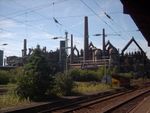 |
Völklingen, 49°14′39.984″N 6°50′59″E / 49.24444000°N 6.84972°E |
ثقافي: (ii), (iv) |
— | 1994 | The recently closed ironworks are the only intact example in western Europe and North America of an intact ironworks built in the 19th and 20th centuries.[140] |
| Wachau Cultural Landscape |  |
Wachau, 48°21′52″N 15°26′3″E / 48.36444°N 15.43417°E |
ثقافي: (ii), (iv) |
18,387 (45,440) | 2000 | The Wachau is a 40 km (25 mi) long valley along the Danube river between Melk and Krems. The valley was settled in prehistoric times and has been an important region since then. It is home to a number of historic towns, villages, monasteries, castles and ruins.[141] |
| The Wadden Sea | 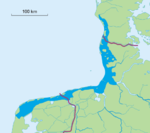 |
53°31′43″N 8°33′22″E / 53.52861°N 8.55611°E |
Natural: (viii), (ix), (x) |
968,393 (2,392,950) | 2009, 2014 | The Wadden Sea contains the Dutch Wadden Sea Conservation Area and the German Wadden Sea National Parks of Lower Saxony and Schleswig-Holstein. The coast line is generally flat and has may mudflats, marshes and dunes. The site covers two-thirds of the entire Wadden Sea and is home to many plant and animal species. It is a breeding ground for up to 12 millions birds annually and supports more than 10 percent of the population of 29 species. In 2014 the original site was expanded to include additional shoreline and wildlife preserves.[142] |
| Wartburg Castle | 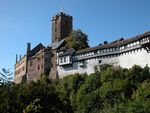 |
Eisenach, 50°58′0.4″N 10°18′25.2″E / 50.966778°N 10.307000°E |
ثقافي: (iii), (vi) |
— | 1999 | Wartburg Castle is located on a 410 m (1230 ft) precipice above Eisenach. It expanded in several sections and only a few of the medieval structures still remain. The castle was rebuilt in the 19th century to its present appearance. Martin Luther translated the New Testament into German while in exile at Wartburg.[143] |
| Westminster Palace, كنيسة وستمنستر and Saint Margaret's Church | 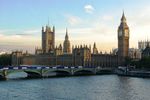 |
لندن, إنگلترة, 51°29′59″N 0°7′43″W / 51.49972°N 0.12861°W |
ثقافي: (i), (ii), (iv) |
10 (25) | 1987 | The site has been involved in the administration of England since the 11th century, and later the United Kingdom. Since the coronation of William the Conqueror, all English and British monarchs have been crowned at Westminster Abbey. Westminster Palace, home to the British Parliament, is an example of Gothic Revival architecture; St Margaret's Church is the palace's parish church, and although it pre-dates the palace and was built in the 11th century, it has been rebuilt since.[144][145][146] |
| Würzburg Residence with the Court Gardens and Residence Square |  |
Würzburg, 49°47′34.008″N 9°56′20.004″E / 49.79278000°N 9.93889000°E |
ثقافي: (i), (iv) |
15 (37) | 1981 | The large and ornate Baroque palace was created under the patronage of the prince-bishops Lothar Franz and Friedrich Carl von Schönborn. It is one of the largest palaces in Germany.[147] |
| Zollverein Coal Mine Industrial Complex | 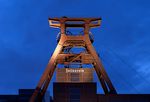 |
Essen, 51°29′29″N 7°2′46″E / 51.49139°N 7.04611°E |
ثقافي: (ii), (iii) |
— | 2001 | The Zollverein industrial complex in Nordrhein-Westfalen contains all the equipment of a historic coal mine which started operation about 150 years ago. Some of the 20th century buildings are also notable.[148] |
انظر أيضاً
- قائمة مواقع التراث العالمي في بلجيكا
- قائمة مواقع التراث العالمي في فرنسا
- قائمة مواقع التراث العالمي في ألمانيا
- قائمة مواقع التراث العالمي في أيرلندا
- قائمة مواقع التراث العالمي في هولندا
- قائمة مواقع التراث العالمي في سويسرا
- قائمة مواقع التراث العالمي في المملكة المتحدة
الهامش
- ^ "Number of World Heritage Properties by region". UNESCO. Retrieved 24 February 2012.
- ^ "Composition of macro geographical (continental) regions, geographical sub-regions, and selected economic and other groupings". Geographical region and composition of each region. United Nations Statistics Division. 2010. Retrieved 24 February 2012.
- ^ "Number of World Heritage properties inscribed each Year". UNESCO. Retrieved 24 February 2012.
- ^ أ ب "The Criteria for Selection". UNESCO. Retrieved 10 September 2011.
- ^ أ ب ت ث "World Heritage List Nominations". UNESCO. Retrieved 28 May 2010. خطأ استشهاد: وسم
<ref>غير صالح؛ الاسم "list" معرف أكثر من مرة بمحتويات مختلفة. - ^ أ ب "World Heritage in Danger". UNESCO. Retrieved 28 May 2010.
- ^ "Cologne Cathedral (Germany), Djoudj Bird Sanctuary (Senegal), Ichkeul National Park (Tunisia), and Hampi (India) removed from List of World Heritage in Danger". UNESCO. Retrieved 29 February 2012.
- ^ "World Heritage Committee threatens to remove Dresden Elbe Valley (Germany) from World Heritage List". UNESCO. Retrieved 24 February 2012.
- ^ "World Heritage Committee keeps Dresden Elbe Valley on UNESCO World Heritage List, urging an end to building of bridge". UNESCO. Retrieved 24 February 2012.
- ^ "Dresden is deleted from UNESCO's World Heritage List". UNESCO. Retrieved 24 February 2012.
- ^ "Aachen Cathedral". UNESCO. Retrieved 29 October 2011.
- ^ "Abbey and Altenmünster of Lorsch". UNESCO. Retrieved 29 October 2011.
- ^ "Abbey Church of Saint-Savin sur Gartempe". UNESCO. Retrieved 29 October 2011.
- ^ "Amiens Cathedral". UNESCO. Retrieved 29 October 2011.
- ^ "Archaeological Ensemble of the Bend of the Boyne". UNESCO. Retrieved 29 October 2011.
- ^ "Arles, Roman and Romanesque Monuments". UNESCO. Retrieved 29 October 2011.
- ^ "Bauhaus and its Sites in Weimar and Dessau". UNESCO. Retrieved 29 October 2011.
- ^ "Droogmakerij de Beemster (Beemster Polder)". UNESCO. Retrieved 20 October 2011.
- ^ "Belfries of Belgium and France". UNESCO. Retrieved 29 October 2011.
- ^ "Benedictine Convent of St John at Müstair". UNESCO. Retrieved 29 October 2011.
- ^ "Bergpark Wilhelmshöhe". UNESCO. Retrieved 24 June 2013.
- ^ "Berlin Modernism Housing Estates". UNESCO. Retrieved 15 February 2012.
- ^ "Blaenavon Industrial Landscape". UNESCO. Retrieved 29 October 2011.
- ^ "Blenheim Palace". UNESCO. Retrieved 30 October 2011.
- ^ "Bordeaux, Port of the Moon". UNESCO. Retrieved 30 October 2011.
- ^ "Bourges Cathedral". UNESCO. Retrieved 30 October 2011.
- ^ "Canal du Midi". UNESCO. Retrieved 30 October 2011.
- ^ "Canterbury Cathedral, St Augustine's Abbey, and St Martin's Church". UNESCO. Retrieved 30 October 2011.
- ^ Church of St Martin, Images of England, http://www.imagesofengland.org.uk/Details/Default.aspx?id=441523, retrieved on 2009-08-16
- ^ St Augustine's Abbey, Pastscape, http://www.pastscape.org.uk/hob.aspx?hob_id=464466, retrieved on 2009-08-16
- ^ "Carolingian Westwork and Civitas Corvey". UNESCO. Retrieved 23 December 2014.
- ^ "Castles and Town Walls of King Edward in Gwynedd". UNESCO. Retrieved 30 October 2011.
- ^ Liddiard (2005), p. 9.
- ^ "Castles of Augustusburg and Falkenlust at Brühl". UNESCO. Retrieved 30 October 2011.
- ^ "Cathedral of Notre-Dame, Former Abbey of Saint-Rémi and Palace of Tau, Reims". UNESCO. Retrieved 30 October 2011.
- ^ "The Causses and the Cévennes". UNESCO. Retrieved 21 February 2012.
- ^ "Chartres Cathedral". UNESCO. Retrieved 30 October 2011.
- ^ "La Chaux-de-Fonds / Le Locle, Watchmaking Town Planning". UNESCO. Retrieved 8 November 2011.
- ^ "Cistercian Abbey of Fontenay". UNESCO. Retrieved 30 October 2011.
- ^ "City of Bath". UNESCO. Retrieved 30 October 2011.
- ^ "City of Graz – Historic Centre and Schloss Eggenberg". UNESCO. Retrieved 7 November 2011.
- ^ "City of Luxembourg: its Old Quarters and Fortifications". UNESCO. Retrieved 30 October 2011.
- ^ "Classical Weimar". UNESCO. Retrieved 39 October 2011.
{{cite web}}: Check date values in:|accessdate=(help) - ^ "Collegiate Church, Castle, and Old Town of Quedlinburg". UNESCO. Retrieved 30 October 2011.
- ^ "Cologne Cathedral Number 1 Attraction" (PDF) (Press release). Cologne Tourist Board. 19 January 2011. Retrieved 20 December 2012.
- ^ "Cologne Cathedral". UNESCO. Retrieved 30 October 2011.
- ^ "Convent of St Gall". UNESCO. Retrieved 31 October 2011.
- ^ "Cornwall and West Devon Mining Landscape". UNESCO. Retrieved 31 October 2011.
- ^ "Decorated Cave of Pont d'Arc, known as Grotte Chauvet-Pont d'Arc, Ardèche". UNESCO. Retrieved 23 December 2014.
- ^ "Defence Line of Amsterdam". UNESCO. Retrieved 31 October 2011.
- ^ "Derwent Valley Mills". UNESCO. Retrieved 31 October 2011.
- ^ Derwent Valley Mills Partnership (2000), pp. 30–31, 96.
- ^ "Dorset and East Devon Coast". UNESCO. Retrieved 8 November 2011.
- ^ "Durham Castle and Cathedral". UNESCO. Retrieved 6 November 2011.
- ^ "Episcopal City of Albi". UNESCO. Retrieved 6 November 2011.
- ^ "Fagus Factory in Alfeld". UNESCO. Retrieved 6 November 2011.
- ^ "Fertö / Neusiedlersee Cultural Landscape". UNESCO. Retrieved 8 November 2011.
- ^ "Flemish Béguinages". UNESCO. Retrieved 6 November 2011.
- ^ "Fortifications of Vauban". UNESCO. Retrieved 6 November 2011.
- ^ "The Four Lifts on the Canal du Centre and their Environs, La Louvière and Le Roeulx (Hainault)". UNESCO. Retrieved 6 November 2011.
- ^ "Frontiers of the Roman Empire". UNESCO. Retrieved 6 November 2011.
- ^ "Garden Kingdom of Dessau-Wörlitz". UNESCO. Retrieved 6 November 2011.
- ^ "Giant's Causeway and Causeway Coast". UNESCO. Retrieved 6 November 2011.
- ^ "La Grand-Place, Brussels". UNESCO. Retrieved 7 November 2011.
- ^ "Gulf of Porto: Calanche of Piana, Gulf of Girolata, Scandola Reserve". UNESCO. Retrieved 7 November 2011.
- ^ "Hallstatt-Dachstein / Salzkammergut Cultural Landscape". UNESCO. Retrieved 7 November 2011.
- ^ "Hanseatic City of Lübeck". UNESCO. Retrieved 7 November 2011.
- ^ "Heart of Neolithic Orkney". UNESCO. Retrieved 7 November 2011.
- ^ "Historic Centre of Avignon: Papal Palace, Episcopal Ensemble and Avignon Bridge". UNESCO. Retrieved 7 November 2011.
- ^ "Historic Centre of Brugge". UNESCO. Retrieved 7 November 2011.
- ^ "Historic Centre of the City of Salzburg". UNESCO. Retrieved 7 November 2011.
- ^ "Historic Centre of Vienna". UNESCO. Retrieved 7 November 2011.
- ^ "Historic Centres of Stralsund and Wismar". UNESCO. Retrieved 7 November 2011.
- ^ "Ironbridge Gorge". UNESCO. Retrieved 8 November 2011.
- ^ "Jurisdiction of Saint-Emilion". UNESCO. Retrieved 8 November 2011.
- ^ "Mill Network at Kinderdijk-Elshout". UNESCO. Retrieved 15 February 2012.
- ^ "Lavaux, Vineyard Terraces". UNESCO. Retrieved 14 February 2012.
- ^ "Le Havre, the City Rebuilt by Auguste Perret". UNESCO. Retrieved 8 November 2011.
- ^ "Liverpool – Maritime Mercantile City". UNESCO. Retrieved 8 November 2011.
- ^ "The Loire Valley between Sully-sur-Loire and Chalonnes". UNESCO. Retrieved 21 February 2012.
- ^ "Maritime Greenwich". UNESCO. Retrieved 16 November 2011.
- ^ "Maulbronn Monastery Complex". UNESCO. Retrieved 15 February 2012.
- ^ "Messel Pit Fossil Site". UNESCO. Retrieved 15 February 2012.
- ^ "Mines of Rammelsberg, Historic Town of Goslar and Upper Harz Water Management System". UNESCO. Retrieved 15 February 2012.
- ^ "Monastic Island of Reichenau". UNESCO. Retrieved 15 February 2012.
- ^ "Mont-Saint-Michel and its Bay". UNESCO. Retrieved 15 February 2012.
- ^ "Monte San Giorgio". UNESCO. Retrieved 14 February 2012.
- ^ "Museumsinsel (Museum Island), Berlin". UNESCO. Retrieved 15 February 2012.
- ^ "Muskauer Park / Park Mużakowski". UNESCO. Retrieved 15 February 2012.
- ^ "Van Nellefabriek". UNESCO. Retrieved 23 December 2014.
- ^ "Neolithic Flint Mines at Spiennes (Mons)". UNESCO. Retrieved 15 February 2012.
- ^ "New Lanark". UNESCO. Retrieved 15 February 2012.
- ^ "Notre-Dame Cathedral in Tournai". UNESCO. Retrieved 21 February 2012.
- ^ "Old City of Bern". UNESCO. Retrieved 14 February 2012.
- ^ "Old and New Towns of Edinburgh". UNESCO. Retrieved 15 February 2012.
- ^ "Old Town of Regensburg with Stadtamhof". UNESCO. Retrieved 15 February 2012.
- ^ "Palace and Gardens of Schönbrunn". UNESCO. Retrieved 20 February 2012.
- ^ "Palace and Park of Fontainebleau". UNESCO. Retrieved 15 February 2012.
- ^ "Palace and Park of Versailles". UNESCO. Retrieved 15 February 2012.
- ^ "Palaces and Parks of Potsdam and Berlin". UNESCO. Retrieved 15 February 2012.
- ^ "Paris, Banks of the Seine". UNESCO. Retrieved 15 February 2012.
- ^ "Pilgrimage Church of Wies". UNESCO. Retrieved 22 February 2012.
- ^ "Place Stanislas, Place de la Carrière and Place d'Alliance in Nancy". UNESCO. Retrieved 15 February 2012.
- ^ "Plantin-Moretus House-Workshops-Museum Complex". UNESCO. Retrieved 15 February 2012.
- ^ "Pontcysyllte Aqueduct and Canal". UNESCO. Retrieved 15 February 2012.
- ^ "Pont du Gard (Roman Aqueduct)". UNESCO. Retrieved 15 February 2012.
- ^ "Prehistoric Pile dwellings around the Alps". UNESCO. Retrieved 14 February 2012.
- ^ "Prehistoric Sites and Decorated Caves of the Vézère Valley". UNESCO. Retrieved 15 February 2012.
- ^ "Primeval Beech Forests of the Carpathians and the Ancient Beech Forests of Germany". UNESCO. Retrieved 14 February 2012.
- ^ "Provins, Town of Medieval Fairs". UNESCO. Retrieved 15 February 2012.
- ^ "Pyrénées - Mont Perdu". UNESCO. Retrieved 15 February 2012.
- ^ "Rhaetian Railway in the Albula / Bernina Landscapes". UNESCO. Retrieved 14 February 2012.
- ^ "Rietveld Schröder House". UNESCO. Retrieved 19 February 2012.
- ^ "Roman Monuments, Cathedral of St. Peter and Church of Our Lady in Trier". UNESCO. Retrieved 21 February 2012.
- ^ "Roman Theatre and its Surroundings and the "Triumphal Arch" of Orange". UNESCO. Retrieved 21 February 2012.
- ^ "Routes of Santiago de Compostela in France". UNESCO. Retrieved 22 February 2012.
- ^ "Royal Botanic Gardens, Kew". UNESCO. Retrieved 19 February 2012.
- ^ "From the Great Saltworks of Salins-les-Bains to the Royal Saltworks of Arc-et-Senans, the Production of Open-pan Salt". UNESCO. Retrieved 20 February 2012.
- ^ "Saltaire". UNESCO. Retrieved 20 February 2012.
- ^ "Schokland and Surroundings". UNESCO. Retrieved 20 February 2012.
- ^ "Semmering railway". UNESCO. Retrieved 20 February 2012.
- ^ "Seventeenth-century canal ring area of Amsterdam inside the Singelgracht". UNESCO. Retrieved 30 October 2011.
- ^ "Skellig Michael". UNESCO. Retrieved 20 February 2012.
- ^ "Speyer Cathedral". UNESCO. Retrieved 20 February 2012.
- ^ "St Kilda". UNESCO. Retrieved 20 February 2012.
- ^ Benvie (2000).
- ^ "St Mary's Cathedral and St Michael's Church at Hildesheim". UNESCO. Retrieved 20 February 2012.
- ^ "Stoclet House". UNESCO. Retrieved 21 February 2012.
- ^ "Stonehenge, Avebury and Associated Sites". UNESCO. Retrieved 21 February 2012.
- ^ "Strasbourg – Grande île". UNESCO. Retrieved 21 February 2012.
- ^ "Studley Royal Park including the Ruins of Fountains Abbey". UNESCO. Retrieved 21 February 2012.
- ^ "Swiss Alps Jungfrau-Aletsch". UNESCO. Retrieved 8 November 2011.
- ^ "Swiss Tectonic Arena Sardona". UNESCO. Retrieved 14 February.
{{cite web}}: Check date values in:|accessdate=(help) - ^ "Three Castles of Bellinzona". UNESCO. Retrieved 14 February 2012.
- ^ "Tower of London". UNESCO. Retrieved 21 February 2012.
- ^ "Town Hall and Roland on the Marketplace of Bremen". UNESCO. Retrieved 21 February 2012.
- ^ "Town of Bamberg". UNESCO. Retrieved 21 February 2012.
- ^ "Upper Middle Rhine Valley". UNESCO. Retrieved 21 February 2012.
- ^ "Vézelay, Church and Hill". UNESCO. Retrieved 21 February 2012.
- ^ "Völklingen Ironworks". UNESCO. Retrieved 22 February 2012.
- ^ "Wachau Cultural Landscape". UNESCO. Retrieved 22 February 2012.
- ^ "The Wadden Sea". UNESCO. Retrieved 23 December 2014.
- ^ "Wartburg Castle". UNESCO. Retrieved 22 February 2012.
- ^ "Westminster Palace, Westminster Abbey and Saint Margaret's Church". UNESCO. Retrieved 22 February 2012.
- ^ "History". Westminster Abbey. Retrieved 15 August 2009.
- ^ Thornbury (1878), p. 567.
- ^ "Würzburg Residence with the Court Gardens and Residence Square". UNESCO. Retrieved 22 February 2012.
- ^ "Zollverein Coal Mine Industrial Complex in Essen". UNESCO. Retrieved 22 February 2012.